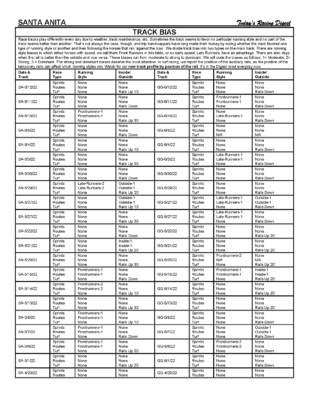How To Use Today's Racing Digest Products
How To Handicap Horses With Track Bias
How to Handicap Horses With Track Bias
Race tracks play differently every day due to weather, normal maintenance, etc. Sometimes the track seems to favor no particular running style and no part of the track seems better than another. That's not always the case, though, and trip handicappers have long made their money by noting whether the track favored one type of running style or another and then following the horses that ran 'against the bias'.
 In Today's Racing Digest's Track Bias report we divide track bias into two types on the main track. There are running style biases in which either horses with speed, we call them Front Runners in this table, or no early speed, Late Runners, have an advantage. There are also days when the rail is better than the outside and vice versa. These biases run from moderate to strong to dominant. The strong and dominant biases deserve the most attention. In turf racing, we report the position of the auxiliary rails, as 'rails up' can promote speed. The strong and dominant biases deserve the most attention.
In Today's Racing Digest's Track Bias report we divide track bias into two types on the main track. There are running style biases in which either horses with speed, we call them Front Runners in this table, or no early speed, Late Runners, have an advantage. There are also days when the rail is better than the outside and vice versa. These biases run from moderate to strong to dominant. The strong and dominant biases deserve the most attention. In turf racing, we report the position of the auxiliary rails, as 'rails up' can promote speed. The strong and dominant biases deserve the most attention.Track bias is used to determine if there was a faster/slower part of the main track and/or if frontrunners or closers had an advantage on that particular day.
There is not a track bias everyday, but we list in our Data Lines if there was a bias. In the Inside/Outside column we also note if the rails were "up" on the turf course and how many feet they were placed outside of the standard setting.
There are three types of track bias ratings: 1-moderate; 2-strong; 3-powerful. There are four designations for how the bias occurred on the race track: F-frontrunners; L-closers; I-inside; O-outside.
An example of a track bias may be F2/I2. This means that frontrunners on the inside ran very well on this day so you may want to look at a closer who was on the outside that was compromised by the bias that day. This horse may be worth considering next time out since it had raced against a track bias on that particular day. When used in conjunction with the trip notes, this can help to point out a better than looked performance.

